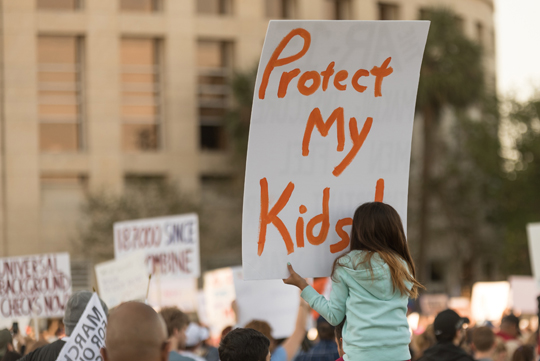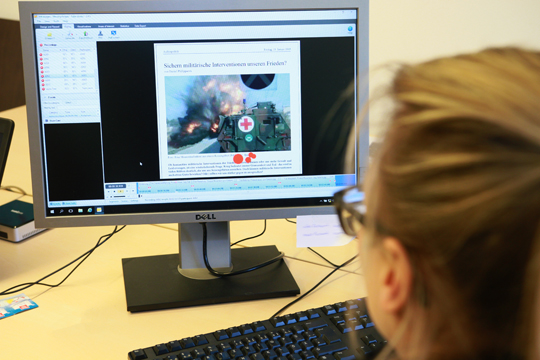Focusing on Images
Freiburg, Sep 05, 2018
What motivates people to stand up for their values and engage in political protest? The political scientist Diana Panke is studying what role images in the media play in this process and whether viewing photographs has an influence on our willingness to take action ourselves.

Protect my kids: a demonstration for more gun control. Photo: Fitz/Fotolia
A flood of visual impressions is part of the daily lives of anyone who reads the newspaper in the morning, browses on the internet during the day, or turns on the television in the evening. News reports without images have become rare, even more so since the dawn of the digital age. In the study “Still Images – Moving People?” Diana Panke, professor of political science at the University of Freiburg, is conducting a research project together with Dr. Stephanie Geise from the University of Münster and Dr. Axel Heck from the University of Kiel to find out whether the emotions evoked when we view media images change our willingness to become politically active ourselves and engage in protest. “Political protest remains a burning issue. The images transported via social media during the refugee crisis, the Pegida demonstrations, or the Arab Spring have engrained themselves in our minds,” says Diana Panke by way of explaining the idea of the project, which is receiving around 156,000 euros in funding for one and a half years from the Friede Springer Foundation.
The Choice of Images
The research team started with a narrower definition of their concept, concentrating on the four political fields of security, economy, animal welfare, and education. The key task for the researchers before starting the actual study was to select the right images. “We took care to select photographs that were unknown. After all, we wanted to study spontaneous reactions to media images,” explains Panke. That is only possible if the images are unknown to the viewer. In a selection study with more than 40 test subjects, the team thus selected four media images from a large pool for each of the two political fields – two judged as positive and two judged as negative.
The main focus was on photographs of objects of protest and protest movements. “In the field of animal welfare, for instance, a photo of a chick running around on a green meadow was judged to be positive, as was a photo depicting cheerfully demonstrating citizens holding up colorful banners. Photos judged to be negative included a picture of a laying battery and shots of masked demonstrators in militant poses.” Then the team gave the pictures the look of typical media images by adding headlines, captions and credits, and a running text. They kept the texts and the layout relatively neutral to ensure their comparability. “After creating the design of the study, we conducted a smaller preliminary study with 20 participants to test whether it really worked like we wanted it to.”
Experimental Design
The main study with 120 test subjects, all of them students at the University of Münster, then ran as follows: First the participants were asked to complete a detailed questionnaire on the computer. Among other things, it included questions on the four political fields and tested their general knowledge on the individual topics. Then the test subjects switched to a different computer, where they received one media report to read on each of the four political fields. By means of the technical method of eye tracking, the researchers measured where they fixed their gaze and for how long. “The thing we were most interested in was how long their gaze remained fixed on the images and what elements of the images the test subjects looked at with particular intensity,” explains the Freiburg scientist.
![]()
In eye tracking, a tiny rail that measures movements of the pupil is built into the computer. The colors yellow and green indicate a shorter viewing time, red a longer viewing time. Photo: Department of Communication, WWU Münster
The eye tracker revealed that the test subjects’ eye movement did not keep to a single consistent course while they were viewing and reading. “Their eyes jumped back and forth: sometimes to the text, and then back to the headline or the image,” she explains – and this although the test subjects knew only that they were taking part in a general study on media, not that it was specifically about the impact of images. “For example, some of them read through the text very carefully, because they didn’t know what questions they would be asked afterwards.”
After the eye tracking experiment, the researchers had the test subjects fill out a second questionnaire to determine more precisely how they had perceived the images – positively, negatively, or neutrally – and what emotions they had given rise to. This second questionnaire also included several questions from the first questionnaire, allowing the researchers to draw inferences on possible changes in the test subjects’ willingness to engage in political protest in the various political fields through a pre/post comparison.
“Our research design has an experimental character, which is relatively unusual in political science but is therefore also very innovative,” says Panke. The goal of the project is to establish a causality between visual perception, affective behavior – that is, the initial unconscious reaction to an image –, and the resulting sensual impression on the one hand and intentional political action on the other. “We thus wanted to find out whether images have the potential to change something about action,” says the Freiburg researcher. Political protest can manifest itself in many different low- and higher-threshold forms: from the collection of signatures over participation in civil movements to militant activities.
Initial Results
Since the research team has not yet met to analyze the data from the main study, the results are still provisional. The task will be to examine the initial hypotheses. “What we want to know first of all is whether the overall duration of image viewing has a positive effect on the willingness for political engagement. In short: Does the effect of the image grow stronger the longer one looks at the image?” The provisional results support this assumption.

The media reports prepared specifically for the study were kept neutral in their presentation in order to ensure comparability of the image effect. Photo: Department of Communication, WWU Münster
The team’s second hypothesis was that the images that evoke strong reactions – whether they be positive or negative – have a stronger influence on willingness to engage in political protest. “For example, the test subjects reacted with strong disapproval to the photo with the laying battery, so here we expect them to be more willing to engage in animal welfare later on,” sums up Panke. Or to take the positive flipside of this example, a tiny chick frolicking around on a lush green meadow should evoke a stronger effect than a more neutral image like that of a group of hens against a grey background. The researcher sees this assumption as having already been confirmed by the analysis of the preliminary study, but the results from the main study are still missing.
The Status of the Hypotheses
The researchers have still not yet integrated several of their hypotheses concerning image selection into the evaluation. For example, the team wants to determine how empathetic the test subjects are. Does viewing objects of protest evoke different reactions than viewing people participating in protest movements? “This is basically the social action model. The goal is to analyze whether people are affected more strongly by images of people who are already politically engaged.” Or, and this would be the strategic model, “they see an object of protest like a laying battery, and it arouses in them certain expectations and interests, making them want to do something about it.”
What always also resonates in this context is the fact that not every area of politics is equally important and equally close to each individual. With regard to the four selected political fields, the research team expects stronger reactions to the topics of education and animal welfare because they play a greater role in the daily lives of the test subjects. “Economy and security, on the other hand, are farther removed from the students’ lifeworld.” However, the researchers have not completed their analysis of this issue.
“Our main finding so far is that the duration of viewing makes a crucial difference. What we can say over and above that on a tentative basis is that there are also great differences in subjective perception,” summarizes Panke. The team is already planning to conduct another study on the same topic after completing the current one, but this time with more test subjects and an even more sophisticated project design.
Judith Burggrabe

